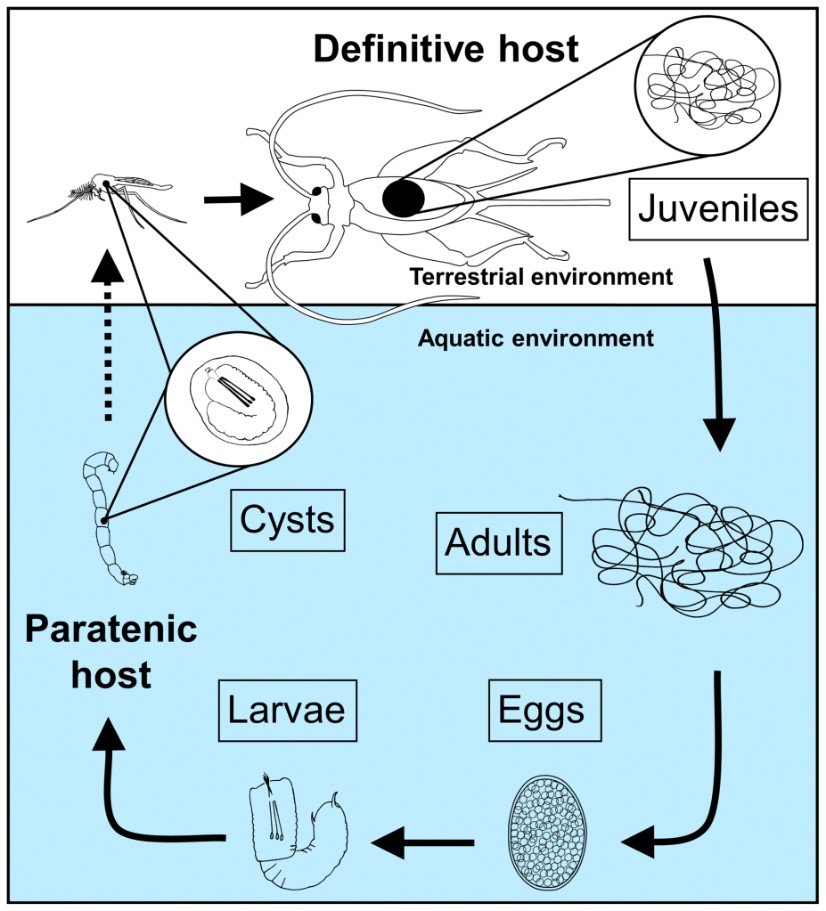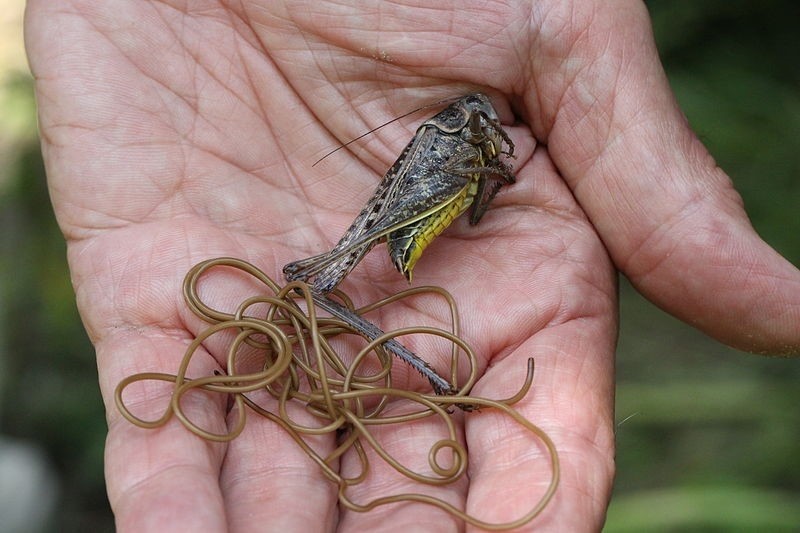By Liepa Adomaityte
Many of us would agree that planet Earth is filled with incredible beauty, and the flora and fauna we observe are breathtaking. However, in many ways, mother nature can also be macabre, horrid, and contain beings that we may only imagine in our nightmares. One of such nightmarish creatures belongs to the phylum Nematomorpha, also known as horsehair worms.
Similar to nematodes in their appearance, these worms are found in wet areas such as streams, puddles, water cisterns and even outside pools (Townsend, L). While the adults are free-living, their larvae, on the other hand, are known to parasitize marine and terrestrial invertebrates such as crustaceans, mantids, beetles and orthopterans (Townsend, L), and their way of parasitizing is terrifyingly fascinating.
The larvae of nematomorphs use not one, but two hosts during their life cycle. Once formed, a larva patiently stays within a protective cyst and waits for a smaller insect, such as a fly or a mosquito, to gobble it up. However, the definite host is a larger insect such as a cricket or a mantid, which consumes the first host. After the final consumption of the larvae, the cyst dissolves and our nematomorph friend uses cuticular hooks to drill through the gut cavity of the insect, where it moves into the hemocoel and absorbs the surrounding nutrients. There, the little larva is able to grow into a massive worm (in some extreme cases they were found to be 2 meters long!) that, after weeks of gorging itself on the delicious insect tissue and moulting, must leave its host. While the image of this animal is already quite chilling, it gets worse; some species of nematomorphs, such as the species Spinochordodes tellinii (The Wildlife Trusts), which parasitize crickets, are able to change the brain chemistry of the host, causing them to take a suicidal dive into a source of water. This is because horsehair worms need to live in a wet area, but in the case of S. tellinii, are unable to leave the host themselves (The Wildlife Trusts). Once the cricket jumps into the water, the worm leaves through a hole in the insect’s body cavity and proceeds his search for a mate. Meanwhile, the cricket, being a land-dwelling animal, is left dead or dying in the water.

Little is known about the taxonomy of these creatures that seem to be straight out of a sci-fi horror film, but we do know that their closest relatives and animals that they often get confused with are nematodes. Within the phylum Nematoda, mermithid worms are very similar to nematomorphs both in their appearance and behaviour, however, mermithids do not possess a terminal cloaca, and have been found to parasitize spiders as well (Bryan et al, 2006). Thus, it seems that when it comes to arthropods, no one is safe from being parasitized; either by nematomorphs or nematodes.

References:
Bryant, M. S., Adlard, R. D., & Cannon, L. R. G. (n.d.). Gordian worms fact sheet – queensland museum. (2006). Retrieved March 29, 2022, from https://web.archive.org/web/20080722175823/http://www.qm.qld.gov.au/inquiry/factsheets/Gordian_Worms_20070605.pdf
Hanelt, B., Bolek, M. G., & Schmidt-Rhaesa, A. (2012). Going solo: discovery of the first parthenogenetic gordiid (Nematomorpha: Gordiida). PLoS One, 7(4), e34472.
Horsehair worm. The Wildlife Trusts. (n.d.). Retrieved March 29, 2022, from https://www.wildlifetrusts.org/wildlife-explorer/marine/worms/horsehair-worm
Simon, M. (2014, May 30). Absurd creature of the week: The parasitic worm that turns crickets into suicidal maniacs. Wired. Retrieved March 28, 2022, from https://www.wired.com/2014/05/absurd-creature-horsehair-worm/
Townsend, L. (n.d.). Horsehair worms by Lee Townsend, extension … – entomology. Retrieved March 29, 2022, from https://entomology.ca.uky.edu/files/efpdf3/ef613.pdf
![]()